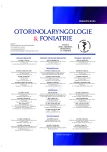Hereditary haemorrhagic telangiectasia – our experience
Authors:
Z. Knížek 1; J. Vodička 1,2; O. Vincent 3; K. Šnorová 4
Authors‘ workplace:
Klinika otorinolaryngologie a chirurgie hlavy a krku, NPK Pardubická nemocnice
1; Fakulta zdravotnických studií, Univerzita Pardubice
2; Radiodiagnostické oddělení, NPK Pardubická nemocnice
3; Oddělení klinické hematologie, NPK Pardubická nemocnice
4
Published in:
Otorinolaryngol Foniatr, 69, 2020, No. 4, pp. 166-171.
Category:
Original Article
Overview
Aims: Hereditary haemorrhagic telangiectasia (HHT) is a rare automosal dominant vascular disease characterized by recurrent epistaxis, mucocutaneous telangiectasias and arteriovenous maloformations, which may be found in different organ systems. The aim of this paper is to present therapeutic modalities of epistaxis and to present system of observation at our department according to international guidelines.
Methods: We observe and manage patients with HHT according to international guidelines since 2015. Patients fill in the Epistaxis severity score (ESS) questionnaire at each visit. We choose therapeutic modality based on ESS score.
Results: 6 patients are regularly observed at our department sice 2015. We found pulmonary AVMs in 2 patients and indicated gastroscopy in 3 patients. Each of therapeutic modalities for epistaxis led to at least mild severity of epistaxis in 4 patiens and moderate severity in 2 patients. Average ESS score at baseline was 6.13, after different therapeutic modalities the average score was 3.28.
Conclusion: Despite HHT is systemic disease, there isn´t centralized care of these patients in Czech Republic. ENT doctor is often a doctor of first contact and therefore should start at least basal diagnosis and management in patients with HHT and should be aware of that management of epistaxis is different from standard epistaxis. According to our observation each patient reacts individually to different therapeutic modalities.
Keywords:
epistaxis – hereditary haemorrhagic telangiectasia – arteriovenous malformation – Young´s procedure – bevacizumab – KTP laser
Sources
1. Assar, O. S., Friedman, C. M., White, R. I., jr.: The natural history of epistaxis in hereditary hemorrhagic telangiectasia. Laryngoscope, 101, 1991, 9, s. 977–980.
2. Faughnan, M. E., Palda, V. A., Garcia-Tsao, G., et al.: International guidelines for the diagnosis and management of hereditary haemorrhagic telangiectasia. J Med Genet, 48, 2011, 2, s. 73–87.
3. Garg, N., Khunger, M., Gupta, A., et al.: Optimal management of hereditary hemorrhagic telangiectasia. J Blood Med, 15, 2014, 10, s. 191–206.
4. Hoag, J., Reh, D., Mitchell, S., et al.: Development of a hereditary hemorrhagic telangiectasia epistaxis severity scoring (HHT--ESS) system. Haematol Meet Rep, 3, 2009, s. 27–28.
5. Chin, Ch. J., Rotenberg, B. W., Witterick, I. J.: Epistaxis in hereditary hemorrhagic telangiectasia: an evidence based review of surgical management. J Otolaryngol Head Neck Surg, 45, 2016, s. 3.
6. Koenighofer, M., Parzefall, T., Frohne, A., et al.: Spectrum of novel hereditary hemorrhagic telangiectasia variants in an austrian patient cohort. Clin Exp Otorhinolaryngol, 12, 2019, 11, s. 405–411.
7. Lund, V. J., Darby, Y., Rimmer, J., et al.: Nasal closure for severe hereditary haemorrhagic telangiectasia in 100 patients. The Lund modification of the Young’s procedure: a 22-year experience. Rhinology, 55, 2017, s. 135–141.
8. Rimmer, J., Lund, V. J.: Hereditary haemorrhagic telangiectasia. Rhinology, 53, 2015, 9, s. 195–203.
9. Shovlin, C. L., Guttmacher, A. E., Buscarini, E., et al.: Diagnostic criteria for hereditary hemorrhagic telangiectasia (Rendu-Osler-Weber syndrome). Am J Med Genet, 91, 2000, 3, s. 66–67.
Labels
Audiology Paediatric ENT ENT (Otorhinolaryngology)Article was published in
Otorhinolaryngology and Phoniatrics

2020 Issue 4
Most read in this issue
- Nasolabial cyst - two case reports and review of literature
- Current classification and staging of middle ear cholesteatoma
- Otitic hydrocephalus: a rare complication of acute suppurative otitis media
- Granulomatosis with polyangiitis of nasal mucosa diagnosed de novo in pregnancy
